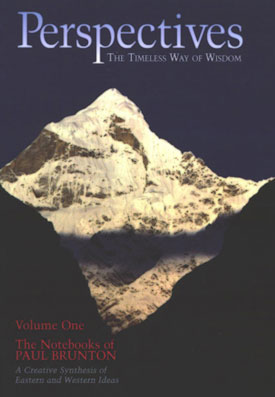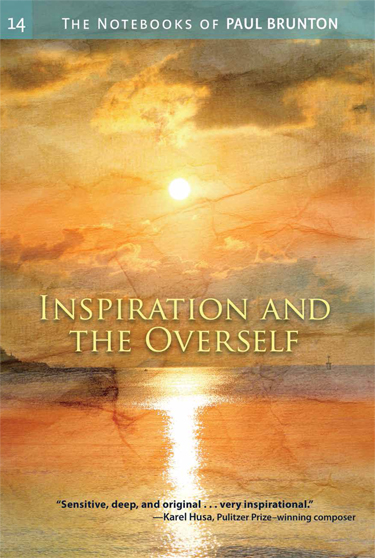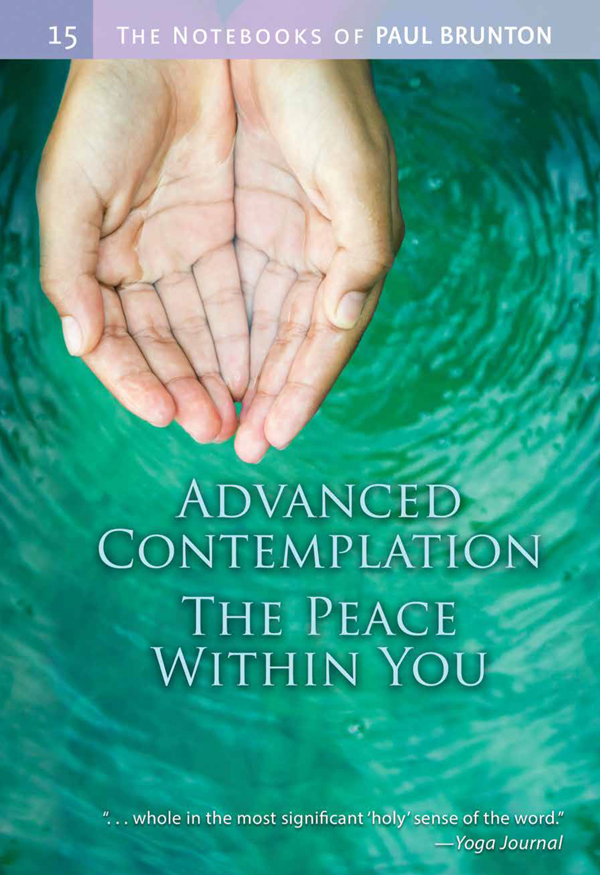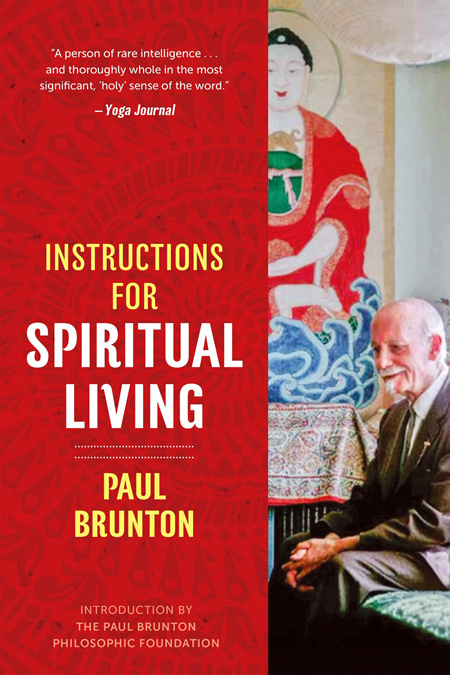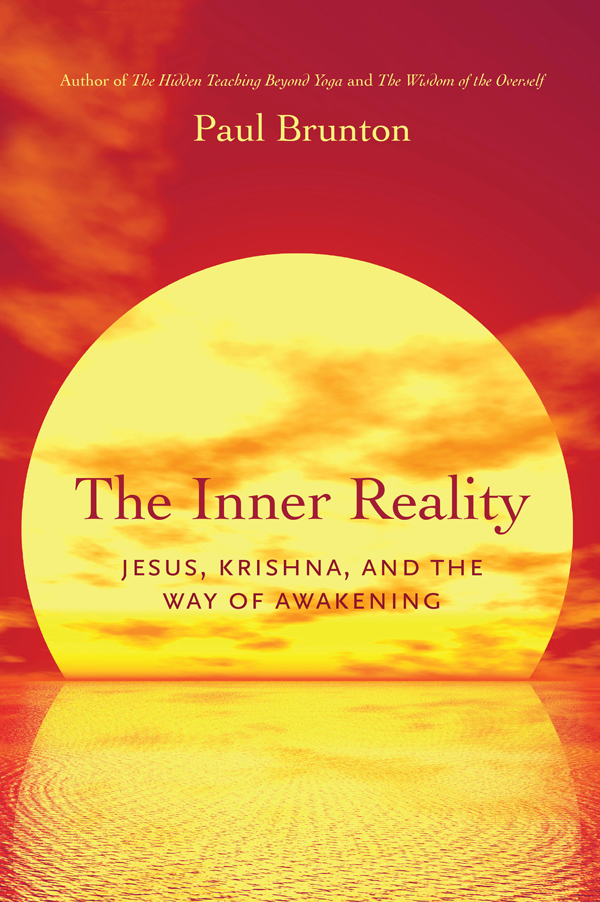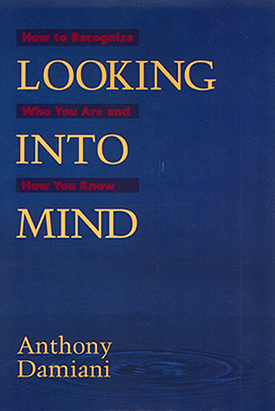The Notebooks of Paul Brunton volume 4, part 1
Meditation By Paul Brunton

Retail/cover price: $15.95
Our price : $12.76
(You save $3.19!)
About this book:
The Notebooks of Paul Brunton volume 4, part 1
Meditation
by Paul Brunton
"The truth needed for immediate and provisional use may be learned from books and teachers, but the truth of the ultimate revelation can be learned only from and within oneself by meditation." —Paul Brunton
Subjects: Spirituality, Meditation
5.75 x 8.5, softcover
(hardcover out of stock)
272 pages
ISBN 10: 0-943914-19-1
ISBN 13: 978-0-943914-19-0
Book Details
Meditation is an inspiring invitation to the most intimate adventure of human spirituality.
This uniquely comprehensive and reliable volume combines a clear explanation of meditation's goal with a rich variety of effective techniques suitable for individual experimentation. It offers detailed and in-depth writings on the why and the how of many varieties of meditation. A section on potential dangers of meditation makes it especially useful for beginners, intermediates, and teachers.
Note: In the cloth edition, Parts 1 and 2 of Volume 4 are bound together as Meditation/The Body, which is currently out of stock.
Category Four: MEDITATION
INTRODUCTION
1. PREPARATORY
The importance of meditation
The true way of meditation
Levels of absorption
Fruits, effects of meditation
Dangers, and how to avoid them
2. PLACE AND CONDITIONS
Times for meditation
Places for meditation
Solitary vs. group meditation
Postures for meditation
Other physical considerations
Proper mental attitude
Regularity of practice
Ending the meditation
3. FUNDAMENTALS
Stop wandering thoughts
Blankness is not the goal
Practise concentrated attention
Varieties of practice
4. MEDITATIVE THINKING
The path of inspired intellect
Self-examination exercises
Moral self-betterment exercises
5. VISUALIZATIONS, SYMBOLS
Visualizations
Symbols
Guru yoga
6. MANTRAMS, AFFIRMATIONS
Mantrams
Affirmations
7. MINDFULNESS, MENTAL QUIET
Mindfulness
Mental quiet
“. . . a veritable treasure-trove of philosophic-spiritual wisdom.” —Elisabeth Kubler-Ross
“. . . sensible and compelling. His work can stand beside that of such East-West bridges as Merton, Huxley, Suzuki, Watts, and Radhakrishnan. It should appeal to anyone concerned personally and academically with issues of spirituality.” —Choice
“Vigorous, clear-minded and independent . . . a synthesis of Eastern mysticism and Western rationality. . . A rich volume.” —Library Journal
“. . . a great gift to us Westerners who are seeking the spiritual.” —Charles T. Tart
“A person of rare intelligence. . . thoroughly alive, and whole in the most significant, 'holy' sense of the word.” —Yoga Journal
For more reviews of the Notebooks series, click here
Meditation is an inspiring invitation to the most intimate adventure of human spirituality: the direct experience of one's own soul. Here P.B. focuses lucidly on a topic for which his extraordinary expertise has been widely acknowledged since he was a young man in the 1930s. He explains the purpose and importance of meditation, provides an unusually rich variety of tested and proven techniques, explains the potential dangers of meditation, and advises how those dangers can be avoided. This section will prove highly useful to beginners and intermediates alike. It should be welcomed by advanced meditators and teachers of meditation as well.
The fourth "category" (major theme) in P.B.'s overall outline of twenty-eight, this section stands in direct relationship to the twenty-third category, Advanced Contemplation. Because of the editorial decisions involved in distinguishing and presenting these two categories, more is required here by way of introductory explanation than has been necessary for any of the previous sections in this series.
As is the case with previous categories, the selection and sequencing of material here is the work of students and not of P.B. himself. Because of the general unfamiliarity in many parts of the West with meditation, however, and because some fundamental ideas might appear unnecessarily confusing if paras were printed somewhat randomly, we have taken much more care in the sequencing within some of the chapters than is our custom. In this particular case, the risk of imposing unintended meanings by context is far outweighed by the risk of obscuring the fundamental clarity with which P.B. approaches and explains this important practice.
Progress in meditation, the inward penetration to deeper and more satisfying levels of the inner reality, can be schematized in several different ways. Two schemas are important to understanding the vast majority of P.B.'s writings on meditation.
The first distinguishes "elementary" and "advanced" practices. All the practices involving willed effort, the struggle to overcome the mind's inherent restlessness and focus it one-pointedly on a single image/idea/ideal to the exclusion of all else, are considered elementary in this schema. Only after such one-pointed concentration can be maintained indefinitely does one intelligently change over to the rapt, highly alert state of inner passivity requisite for the advanced practices.
This division into elementary and advanced practices is the one that distinguishes the fourth and twenty-third categories from one another in P.B.'s general outline. But since the practices considered "elementary" in such a schema are far from "elementary" in the practice of most meditators and would-be meditators, and since these practices include nearly all of what is generally recommended by way of "meditation" to spiritual seekers in the modern West, we felt that P.B.'s title of Elementary Meditation could be misleading to the majority of Westerners now practicing some form of meditation. Feeling ourselves forced to offer the present form of introductory explanation in either case, we have chosen to use Meditation as the title on the cover of this volume rather than the somewhat technical term Elementary Meditation from the original outline.
The second general schematization of stages of practice that it will be helpful for readers to understand is threefold. Within the generic term "meditation," it distinguishes three stages: concentration, meditation proper, and contemplation. Though there are occasional exceptions and further elaborations, this threefold framework is the one that readers will find most useful in understanding the material in this volume. These three stages are quite clearly explained in the section on "Levels of absorption" in Chapter 1. The reader should also be aware that the word "meditation" is sometimes used as a generic term covering all three of these stages, and that it is sometimes used more technically to mean only the second of these three stages. Informed of both these usages, readers should have little difficulty discovering for themselves which meaning is appropriate to individual paras.
Editorial conventions for this category are the same as stated in introductions to earlier volumes. Likewise, (P) at the end of a para indicates that it is one of the relatively few paras we felt it also appears in Perspectives, the introductory volume to this series.
INTRODUCTORY
MEDITATION is really the mind thinking of the Soul, just as Activity is the mind thinking of the World.
IT IS HABITUAL, hence called natural, for present-day humanity to go along with the mental flow to outside things. Meditation reverses this direction and tries to bring the little mind back to its origin — Mind.
From chapter 1: PREPARATORY
The importance of meditation
1
Of all the day's activities, this non-activity, this retreat into meditation, must become the principal one. It ought to be the centre, with all the others circling round it.
2
For the religionist, meditation is essential because a nonchalant faith alone is not enough. He who indulges in theological speculation about the soul without having trod the inner way to the actual experience of it for himself is like a man standing outside a restaurant with shuttered windows and purporting to describe the meals being served inside. The religious mode of life is intended to prepare man for and to lead him eventually to the mystical mode, which is a higher rung in his development.
For the moralist, meditation is essential because a code of morals or a creed of ethics is only a preliminary aid to the fulfilment of life's purpose — which is to know ourselves. Our morals will automatically adjust themselves, our credo of ethics will automatically right itself once we have come into spiritual self-enlightenment. The noblest and the highest within us will then be evoked spontaneously. A technique of mind-training is indispensable to true self-knowledge.
Meditation is also essential for the artist. However talented he may be, a man can produce only substitutes for works of genius if he lacks the capacity to achieve self-absorbed states. The cultivation of this habit is a powerful help to the development of inspired moods. This is an age of brilliance. The talent for wit, satire, and sophistication abounds. But the true artist needs to go deeper than that. Art which lacks a spiritual import possesses only a surface value. The sun of inspiration shines upon all alike, but few people are so constituted as to be able to behold it. This is partly because they cannot achieve the requisite psychological condition. The artist who is wrapped up in a semi-trance of creative endeavour hardly notices at the time where he is and hardly remembers his own past life — such is the intensity of his concentration. Thus mental quiet is not to be confused with mental laziness. It is not only a triumph over the one-sidedness of external activity but also a creative quiet. This truth achieves its fullest exemplification in the sphere of art.
For the overworked man of affairs or the tired man of action, meditation is essential because it affords a wonderful relief by creating a little secret place within himself where the sordid world will be less able to hurt him, the events of life less able to depress him. Moreover, he needs meditation not only because an unrestrained external activity is not enough but also because it brings up out of the subconscious stores unexpected ideas which may be what he was consciously seeking previously or provides him with swift intuitions which throw light on perplexing problems. How much did their early morning practice of prefacing the day's work with a half hour of devotional meditation and guidance-seeking help some famous historical figures!
For the idealist who is struggling in a hard and harsh world, short daily periods of meditation will in time become the blessed sanctuary wherein he can keep alive his repressed aspirations.
Finally meditation is essential for every man because without it he lives at too great a radius from his divine centre to understand the best thing which life can offer him. He must reclaim the divine estate of which he is the ignorant owner. O! it is worthwhile to make this sacred incursion and attain, for a time, a nobler and wiser state of himself. By this daily act of returning into himself, he reaffirms his divine dignity and practises true self-respect.
3
Spirituality is within. If one does not feel it, then one needs to search deeper, beneath the weaknesses, faults, passions, and desires of the ego. It is still there, but the search must be properly made. This is where help can be found, in the words of those who have already found it.
4
It is a fact of mere observation that most Western men live throughout their wakeful existence from morning to night without finding a few minutes — or even caring to find them — for the liberating practice of meditation exercises. They are virtually imprisoned in the five senses and in the thoughts arising from each sense-activity. This fact is a lamentable one. For how can they hope to cultivate a higher life if this essential aid be neglected?
5
The consciousness beyond the usual everyday consciousness can be reached only after a disciplined training of the mind. This suppresses its activity in thinking and banishes its extroverted worldliness of character.
From chapter 3: FUNDAMENTALS
Stop wandering thoughts
1
The longest book on yoga can teach you nothing more about the practical aim of yoga than this: still your thoughts.
2
One of the causes of the failure to get any results from meditation is that the meditator has not practised long enough. In fact, the wastage of much time in unprofitable, distracted, rambling thinking seems to be the general experience. Yet this is the prelude to the actual work of meditation in itself. It is a necessary excavation before the building can be erected. The fact is unpleasant but must be accepted. If this experience of the first period is frustrating and disappointing, the experience of the second period is happy and rewarding. He should really count the first period as a preparation, and not as a defeat. If the preliminary period is so irksome that it seems like an artificial activity, and the subsequent period of meditation itself is so pleasant and effortless that it seems like a perfectly natural one, the moral is: more perseverance and more patience.
3
If the turning wheel of thoughts can be brought to a perfect standstill without paying the penalty of sleep, the results will be that the Thinker will come to know himself instead of his thoughts.
4
Meditation is admittedly one of the most difficult arts to learn. The mind of humanity in its present-day condition is so restless, so wandering, and especially so extroverted, that the effort to bring it under control seems to the beginner to meet with disheartening results. Proper patience, right technique, and the mental help of an expert are needed. In most cases it takes several years, but from experience and knowledge there may come the skill and ease of the proficient meditator.
5
A rabble of thoughts pursue him into the silence period, as if determined to keep his mind from ever becoming still.
6
It is useful only in the most elementary stage to let thoughts drift hazily or haphazardly during the allotted period. For at that stage, he needs more to make the idea of sitting perfectly still for some time quite acceptable in practice than he needs to begin withdrawal from the body's sense. He must first gain command of his body before he can gain command of his thoughts. But in the next stage, he must forcibly direct attention to a single subject and forcibly sustain it there. He must begin to practise mental mastery, for this will not only bring him the spiritual profits of meditation but also will ward off some of its psychic dangers.
7
Do not miss the object of your meditations and lose yourself in useless reveries.
8
The moral is, find the object that makes most appeal to your temperament, the object that experience proves to be most effective in inducing the condition of mental concentration.
9
The first quarter-hour is often so fatiguing to beginners that they look for, and easily find, an excuse to bring the practice to an abrupt end, thus failing in it. They may frankly accept the fatigue itself as sufficient reason for their desertion. Or they may make the excuse of attending to some other task waiting to be done. But the fact is that almost as soon as they start, they do not want to go on. They sit down to meditate and then they find they do not want to meditate! Why? The answer lies in the intellect's intractable restlessness, its inherent repugnance to being governed or being still.
From chapter 7: MINDFULNESS, MENTAL QUIET
Mindfulness
1
Although everyone must begin by making meditation something to be practised at particular times only, he must end by making it an essential background to his whole life. Even under the pressure of inescapable outward occupation, it ought to be still continuing as the screen upon which these occupational activities appear.
2
Keep on remembering to observe yourself, to watch yourself, to become aware of what you are thinking, feeling, saying, or doing. This is one of the most valuable exercises of the Quest.
3
Whatever one is doing, to stop suddenly at an unarranged moment and in an unforeseen position becomes a useful exercise when repeated several times every day. It is necessary to hold the whole body rigidly fixed in exactly the posture which had been reached at the very moment of command. Even the expression on the face and the thought in the mind must be included. This is one of the "Awareness" exercises; they are performed when sitting, walking, working, eating, or moving.
4
This exercise of self-vigilance is a daily and hourly one, for the intrusions of negative moods and destructive thoughts are daily and hourly, too.
5
Walking meditation: The practice of meditation can be continued even while walking. This is done in a slow dignified way, starting with the right foot and the heel touching the ground first, on the expiring breath. Then continue rhythmically, slowly, a measured pace - without haste and without turning the head right and left. The monk I saw was walking with head down, and looking at the ground. He was in Thailand.
6
In the end, he will make no separation between everyday ordinary routine and the period of meditation — for the whole of his life will become one continuous meditation. His actions will then take place within its atmosphere. But in the beginning he must make this separation.
7
As you go about your daily work in your ordinary life and in relations with other people, in hours of toil or pleasure, or indeed at any period of your life, remember the Overself.
8
The Way of Mindfulness in Buddhism, of deliberately being conscious of each physical action quite apart from the action itself, produces a different state from that of the ordinary person who may outwardly perform the same action. It develops concentration and an awareness which ultimately leads to the awareness of the being himself who practises the exercise. The ordinary person is lost in the action itself, in the thought itself, in the speech itself, and has no separate awareness of them. Practice of mindfulness gives a conscious responsibility for what is being done, what is being thought, and what is being said quite apart from what is observed and heard. It lights him up from within with intense concentration. This is a mental discipline practised daily by the Buddhist monks and useful to other seekers.
9
By means of this exercise in mindfulness, whatever he is doing and whatever he is working at is no longer the mere work or action itself. It is also a part of his spiritual training, his self-discipline, his concentration practice, and ultimately his separate awareness and responsibility for himself.
10
A housewife wrote to me that she found herself too busy with her duties to sit down and meditate; but by thinking about spiritual subjects as she went about her work, she found with time that this not only lightened the drudgery but also developed into a kind of meditation itself.
In his own words:
“Writing, which is an exercise of the intellect to some, is an act of worship to me. I rise from my desk in the same mood as that in which I leave an hour of prayer in an old cathedral, or of meditation in a little wood . . .” —from Perspectives, volume 1 in The Notebooks of Paul Brunton, p. 143
“P.B. as a private person does not count. There are hundreds of millions of such persons anyway. What is one man and his quest? P.B.’s personal experiences and views are not of any particular importance or special consequence. What happens to the individual man named P.B. is a matter of no account to anyone except himself. But what happens to the hundreds of thousands of spiritual seekers today who are following the same path that he pioneered is a serious matter and calls for prolonged consideration. Surely the hundreds of thousands of Western seekers who stand behind him and whom indeed, in one sense, he represents, do count. P.B. as a symbol of the scattered group of Western truth-seekers who, by following his writings so increasingly and so eagerly, virtually follow him also, does count. He personifies their aspirations, their repulsion from materialism and attraction toward mysticism, their interest in Oriental wisdom and their shepherdless state. As a symbol of this Western movement of thought, he is vastly greater than himself. In his mind and person the historic need for a new grasp of the contemporary spiritual problem found a plain-speaking voice . . .” —from Perspectives, volume 1 in The Notebooks of Paul Brunton, p. 145
Learn more about Paul Brunton through articles at the Paul Brunton Philosophic Foundation web site
Ebook
Electronic versions of this book are available from all major (Amazon Kindle, Barnes & Noble, Apple, Kobo, etc.) and most smaller ebook vendors. Please don't try to order ebooks directly from us, as we are not yet able to deliver anything to you in a preferred electronic format.
Hardcover
We are currently out of stock of this volume in hardcover.
To see all our Paul Brunton titles, scroll down to The Complete Paul Brunton Opus below.
Click here to see or order the complete set of The Notebooks of Paul Brunton.
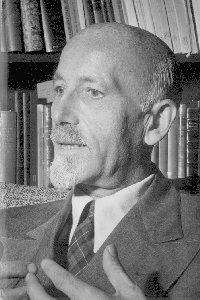
Paul Brunton helps us hear the melody behind the medley of today's "spiritual marketplace." His late writings raise the bar for what we can expect of spiritual teachings and teachers, and what we can do for ourselves. Born in London in 1898, he soon became a leading pioneer of much of what we now take for granted. He traveled widely throughout the world (long before it was fashionable) to meet living masters of various traditions with whom he then lived and studied. His eleven early books from 1934–1952 shared much of what he learned, and helped set the stage for dramatic east-west exchanges of the late 20th century. Paul Brunton left more than 10,000 pages of enormously helpful new work in notebooks he reserved for posthumous publication, much of which is now available as The Notebooks of Paul Brunton. See "The Complete Paul Brunton Opus" in blue below to see his many works available on this site. You can also search on Paul Brunton in the search bar to browse the selections, or click on a link below for specific connections.
Click here for an article about Paul Brunton.
Click here for The Notebooks of Paul Brunton.
To access small theme-based books compiled from Paul Brunton's writings, scroll down to Derived from the Notebooks below.
To access Paul Brunton's early writings, published from 1934–1952, scroll down to Paul Brunton's Early Works below.
To access commentaries on Paul Brunton and his work by his leading student, Anthony Damiani, as well as other writings about Paul Brunton and/or his work, scroll down to Commentaries and Reflections on Paul Brunton and His Work below.
Book Details
Meditation is an inspiring invitation to the most intimate adventure of human spirituality.
This uniquely comprehensive and reliable volume combines a clear explanation of meditation's goal with a rich variety of effective techniques suitable for individual experimentation. It offers detailed and in-depth writings on the why and the how of many varieties of meditation. A section on potential dangers of meditation makes it especially useful for beginners, intermediates, and teachers.
Note: In the cloth edition, Parts 1 and 2 of Volume 4 are bound together as Meditation/The Body, which is currently out of stock.
Category Four: MEDITATION
INTRODUCTION
1. PREPARATORY
The importance of meditation
The true way of meditation
Levels of absorption
Fruits, effects of meditation
Dangers, and how to avoid them
2. PLACE AND CONDITIONS
Times for meditation
Places for meditation
Solitary vs. group meditation
Postures for meditation
Other physical considerations
Proper mental attitude
Regularity of practice
Ending the meditation
3. FUNDAMENTALS
Stop wandering thoughts
Blankness is not the goal
Practise concentrated attention
Varieties of practice
4. MEDITATIVE THINKING
The path of inspired intellect
Self-examination exercises
Moral self-betterment exercises
5. VISUALIZATIONS, SYMBOLS
Visualizations
Symbols
Guru yoga
6. MANTRAMS, AFFIRMATIONS
Mantrams
Affirmations
7. MINDFULNESS, MENTAL QUIET
Mindfulness
Mental quiet
“. . . a veritable treasure-trove of philosophic-spiritual wisdom.” —Elisabeth Kubler-Ross
“. . . sensible and compelling. His work can stand beside that of such East-West bridges as Merton, Huxley, Suzuki, Watts, and Radhakrishnan. It should appeal to anyone concerned personally and academically with issues of spirituality.” —Choice
“Vigorous, clear-minded and independent . . . a synthesis of Eastern mysticism and Western rationality. . . A rich volume.” —Library Journal
“. . . a great gift to us Westerners who are seeking the spiritual.” —Charles T. Tart
“A person of rare intelligence. . . thoroughly alive, and whole in the most significant, 'holy' sense of the word.” —Yoga Journal
For more reviews of the Notebooks series, click here
Meditation is an inspiring invitation to the most intimate adventure of human spirituality: the direct experience of one's own soul. Here P.B. focuses lucidly on a topic for which his extraordinary expertise has been widely acknowledged since he was a young man in the 1930s. He explains the purpose and importance of meditation, provides an unusually rich variety of tested and proven techniques, explains the potential dangers of meditation, and advises how those dangers can be avoided. This section will prove highly useful to beginners and intermediates alike. It should be welcomed by advanced meditators and teachers of meditation as well.
The fourth "category" (major theme) in P.B.'s overall outline of twenty-eight, this section stands in direct relationship to the twenty-third category, Advanced Contemplation. Because of the editorial decisions involved in distinguishing and presenting these two categories, more is required here by way of introductory explanation than has been necessary for any of the previous sections in this series.
As is the case with previous categories, the selection and sequencing of material here is the work of students and not of P.B. himself. Because of the general unfamiliarity in many parts of the West with meditation, however, and because some fundamental ideas might appear unnecessarily confusing if paras were printed somewhat randomly, we have taken much more care in the sequencing within some of the chapters than is our custom. In this particular case, the risk of imposing unintended meanings by context is far outweighed by the risk of obscuring the fundamental clarity with which P.B. approaches and explains this important practice.
Progress in meditation, the inward penetration to deeper and more satisfying levels of the inner reality, can be schematized in several different ways. Two schemas are important to understanding the vast majority of P.B.'s writings on meditation.
The first distinguishes "elementary" and "advanced" practices. All the practices involving willed effort, the struggle to overcome the mind's inherent restlessness and focus it one-pointedly on a single image/idea/ideal to the exclusion of all else, are considered elementary in this schema. Only after such one-pointed concentration can be maintained indefinitely does one intelligently change over to the rapt, highly alert state of inner passivity requisite for the advanced practices.
This division into elementary and advanced practices is the one that distinguishes the fourth and twenty-third categories from one another in P.B.'s general outline. But since the practices considered "elementary" in such a schema are far from "elementary" in the practice of most meditators and would-be meditators, and since these practices include nearly all of what is generally recommended by way of "meditation" to spiritual seekers in the modern West, we felt that P.B.'s title of Elementary Meditation could be misleading to the majority of Westerners now practicing some form of meditation. Feeling ourselves forced to offer the present form of introductory explanation in either case, we have chosen to use Meditation as the title on the cover of this volume rather than the somewhat technical term Elementary Meditation from the original outline.
The second general schematization of stages of practice that it will be helpful for readers to understand is threefold. Within the generic term "meditation," it distinguishes three stages: concentration, meditation proper, and contemplation. Though there are occasional exceptions and further elaborations, this threefold framework is the one that readers will find most useful in understanding the material in this volume. These three stages are quite clearly explained in the section on "Levels of absorption" in Chapter 1. The reader should also be aware that the word "meditation" is sometimes used as a generic term covering all three of these stages, and that it is sometimes used more technically to mean only the second of these three stages. Informed of both these usages, readers should have little difficulty discovering for themselves which meaning is appropriate to individual paras.
Editorial conventions for this category are the same as stated in introductions to earlier volumes. Likewise, (P) at the end of a para indicates that it is one of the relatively few paras we felt it also appears in Perspectives, the introductory volume to this series.
INTRODUCTORY
MEDITATION is really the mind thinking of the Soul, just as Activity is the mind thinking of the World.
IT IS HABITUAL, hence called natural, for present-day humanity to go along with the mental flow to outside things. Meditation reverses this direction and tries to bring the little mind back to its origin — Mind.
From chapter 1: PREPARATORY
The importance of meditation
1
Of all the day's activities, this non-activity, this retreat into meditation, must become the principal one. It ought to be the centre, with all the others circling round it.
2
For the religionist, meditation is essential because a nonchalant faith alone is not enough. He who indulges in theological speculation about the soul without having trod the inner way to the actual experience of it for himself is like a man standing outside a restaurant with shuttered windows and purporting to describe the meals being served inside. The religious mode of life is intended to prepare man for and to lead him eventually to the mystical mode, which is a higher rung in his development.
For the moralist, meditation is essential because a code of morals or a creed of ethics is only a preliminary aid to the fulfilment of life's purpose — which is to know ourselves. Our morals will automatically adjust themselves, our credo of ethics will automatically right itself once we have come into spiritual self-enlightenment. The noblest and the highest within us will then be evoked spontaneously. A technique of mind-training is indispensable to true self-knowledge.
Meditation is also essential for the artist. However talented he may be, a man can produce only substitutes for works of genius if he lacks the capacity to achieve self-absorbed states. The cultivation of this habit is a powerful help to the development of inspired moods. This is an age of brilliance. The talent for wit, satire, and sophistication abounds. But the true artist needs to go deeper than that. Art which lacks a spiritual import possesses only a surface value. The sun of inspiration shines upon all alike, but few people are so constituted as to be able to behold it. This is partly because they cannot achieve the requisite psychological condition. The artist who is wrapped up in a semi-trance of creative endeavour hardly notices at the time where he is and hardly remembers his own past life — such is the intensity of his concentration. Thus mental quiet is not to be confused with mental laziness. It is not only a triumph over the one-sidedness of external activity but also a creative quiet. This truth achieves its fullest exemplification in the sphere of art.
For the overworked man of affairs or the tired man of action, meditation is essential because it affords a wonderful relief by creating a little secret place within himself where the sordid world will be less able to hurt him, the events of life less able to depress him. Moreover, he needs meditation not only because an unrestrained external activity is not enough but also because it brings up out of the subconscious stores unexpected ideas which may be what he was consciously seeking previously or provides him with swift intuitions which throw light on perplexing problems. How much did their early morning practice of prefacing the day's work with a half hour of devotional meditation and guidance-seeking help some famous historical figures!
For the idealist who is struggling in a hard and harsh world, short daily periods of meditation will in time become the blessed sanctuary wherein he can keep alive his repressed aspirations.
Finally meditation is essential for every man because without it he lives at too great a radius from his divine centre to understand the best thing which life can offer him. He must reclaim the divine estate of which he is the ignorant owner. O! it is worthwhile to make this sacred incursion and attain, for a time, a nobler and wiser state of himself. By this daily act of returning into himself, he reaffirms his divine dignity and practises true self-respect.
3
Spirituality is within. If one does not feel it, then one needs to search deeper, beneath the weaknesses, faults, passions, and desires of the ego. It is still there, but the search must be properly made. This is where help can be found, in the words of those who have already found it.
4
It is a fact of mere observation that most Western men live throughout their wakeful existence from morning to night without finding a few minutes — or even caring to find them — for the liberating practice of meditation exercises. They are virtually imprisoned in the five senses and in the thoughts arising from each sense-activity. This fact is a lamentable one. For how can they hope to cultivate a higher life if this essential aid be neglected?
5
The consciousness beyond the usual everyday consciousness can be reached only after a disciplined training of the mind. This suppresses its activity in thinking and banishes its extroverted worldliness of character.
From chapter 3: FUNDAMENTALS
Stop wandering thoughts
1
The longest book on yoga can teach you nothing more about the practical aim of yoga than this: still your thoughts.
2
One of the causes of the failure to get any results from meditation is that the meditator has not practised long enough. In fact, the wastage of much time in unprofitable, distracted, rambling thinking seems to be the general experience. Yet this is the prelude to the actual work of meditation in itself. It is a necessary excavation before the building can be erected. The fact is unpleasant but must be accepted. If this experience of the first period is frustrating and disappointing, the experience of the second period is happy and rewarding. He should really count the first period as a preparation, and not as a defeat. If the preliminary period is so irksome that it seems like an artificial activity, and the subsequent period of meditation itself is so pleasant and effortless that it seems like a perfectly natural one, the moral is: more perseverance and more patience.
3
If the turning wheel of thoughts can be brought to a perfect standstill without paying the penalty of sleep, the results will be that the Thinker will come to know himself instead of his thoughts.
4
Meditation is admittedly one of the most difficult arts to learn. The mind of humanity in its present-day condition is so restless, so wandering, and especially so extroverted, that the effort to bring it under control seems to the beginner to meet with disheartening results. Proper patience, right technique, and the mental help of an expert are needed. In most cases it takes several years, but from experience and knowledge there may come the skill and ease of the proficient meditator.
5
A rabble of thoughts pursue him into the silence period, as if determined to keep his mind from ever becoming still.
6
It is useful only in the most elementary stage to let thoughts drift hazily or haphazardly during the allotted period. For at that stage, he needs more to make the idea of sitting perfectly still for some time quite acceptable in practice than he needs to begin withdrawal from the body's sense. He must first gain command of his body before he can gain command of his thoughts. But in the next stage, he must forcibly direct attention to a single subject and forcibly sustain it there. He must begin to practise mental mastery, for this will not only bring him the spiritual profits of meditation but also will ward off some of its psychic dangers.
7
Do not miss the object of your meditations and lose yourself in useless reveries.
8
The moral is, find the object that makes most appeal to your temperament, the object that experience proves to be most effective in inducing the condition of mental concentration.
9
The first quarter-hour is often so fatiguing to beginners that they look for, and easily find, an excuse to bring the practice to an abrupt end, thus failing in it. They may frankly accept the fatigue itself as sufficient reason for their desertion. Or they may make the excuse of attending to some other task waiting to be done. But the fact is that almost as soon as they start, they do not want to go on. They sit down to meditate and then they find they do not want to meditate! Why? The answer lies in the intellect's intractable restlessness, its inherent repugnance to being governed or being still.
From chapter 7: MINDFULNESS, MENTAL QUIET
Mindfulness
1
Although everyone must begin by making meditation something to be practised at particular times only, he must end by making it an essential background to his whole life. Even under the pressure of inescapable outward occupation, it ought to be still continuing as the screen upon which these occupational activities appear.
2
Keep on remembering to observe yourself, to watch yourself, to become aware of what you are thinking, feeling, saying, or doing. This is one of the most valuable exercises of the Quest.
3
Whatever one is doing, to stop suddenly at an unarranged moment and in an unforeseen position becomes a useful exercise when repeated several times every day. It is necessary to hold the whole body rigidly fixed in exactly the posture which had been reached at the very moment of command. Even the expression on the face and the thought in the mind must be included. This is one of the "Awareness" exercises; they are performed when sitting, walking, working, eating, or moving.
4
This exercise of self-vigilance is a daily and hourly one, for the intrusions of negative moods and destructive thoughts are daily and hourly, too.
5
Walking meditation: The practice of meditation can be continued even while walking. This is done in a slow dignified way, starting with the right foot and the heel touching the ground first, on the expiring breath. Then continue rhythmically, slowly, a measured pace - without haste and without turning the head right and left. The monk I saw was walking with head down, and looking at the ground. He was in Thailand.
6
In the end, he will make no separation between everyday ordinary routine and the period of meditation — for the whole of his life will become one continuous meditation. His actions will then take place within its atmosphere. But in the beginning he must make this separation.
7
As you go about your daily work in your ordinary life and in relations with other people, in hours of toil or pleasure, or indeed at any period of your life, remember the Overself.
8
The Way of Mindfulness in Buddhism, of deliberately being conscious of each physical action quite apart from the action itself, produces a different state from that of the ordinary person who may outwardly perform the same action. It develops concentration and an awareness which ultimately leads to the awareness of the being himself who practises the exercise. The ordinary person is lost in the action itself, in the thought itself, in the speech itself, and has no separate awareness of them. Practice of mindfulness gives a conscious responsibility for what is being done, what is being thought, and what is being said quite apart from what is observed and heard. It lights him up from within with intense concentration. This is a mental discipline practised daily by the Buddhist monks and useful to other seekers.
9
By means of this exercise in mindfulness, whatever he is doing and whatever he is working at is no longer the mere work or action itself. It is also a part of his spiritual training, his self-discipline, his concentration practice, and ultimately his separate awareness and responsibility for himself.
10
A housewife wrote to me that she found herself too busy with her duties to sit down and meditate; but by thinking about spiritual subjects as she went about her work, she found with time that this not only lightened the drudgery but also developed into a kind of meditation itself.
In his own words:
“Writing, which is an exercise of the intellect to some, is an act of worship to me. I rise from my desk in the same mood as that in which I leave an hour of prayer in an old cathedral, or of meditation in a little wood . . .” —from Perspectives, volume 1 in The Notebooks of Paul Brunton, p. 143
“P.B. as a private person does not count. There are hundreds of millions of such persons anyway. What is one man and his quest? P.B.’s personal experiences and views are not of any particular importance or special consequence. What happens to the individual man named P.B. is a matter of no account to anyone except himself. But what happens to the hundreds of thousands of spiritual seekers today who are following the same path that he pioneered is a serious matter and calls for prolonged consideration. Surely the hundreds of thousands of Western seekers who stand behind him and whom indeed, in one sense, he represents, do count. P.B. as a symbol of the scattered group of Western truth-seekers who, by following his writings so increasingly and so eagerly, virtually follow him also, does count. He personifies their aspirations, their repulsion from materialism and attraction toward mysticism, their interest in Oriental wisdom and their shepherdless state. As a symbol of this Western movement of thought, he is vastly greater than himself. In his mind and person the historic need for a new grasp of the contemporary spiritual problem found a plain-speaking voice . . .” —from Perspectives, volume 1 in The Notebooks of Paul Brunton, p. 145
Learn more about Paul Brunton through articles at the Paul Brunton Philosophic Foundation web site
Ebook
Electronic versions of this book are available from all major (Amazon Kindle, Barnes & Noble, Apple, Kobo, etc.) and most smaller ebook vendors. Please don't try to order ebooks directly from us, as we are not yet able to deliver anything to you in a preferred electronic format.
Hardcover
We are currently out of stock of this volume in hardcover.
To see all our Paul Brunton titles, scroll down to The Complete Paul Brunton Opus below.
Click here to see or order the complete set of The Notebooks of Paul Brunton.
About Paul Brunton

Paul Brunton helps us hear the melody behind the medley of today's "spiritual marketplace." His late writings raise the bar for what we can expect of spiritual teachings and teachers, and what we can do for ourselves. Born in London in 1898, he soon became a leading pioneer of much of what we now take for granted. He traveled widely throughout the world (long before it was fashionable) to meet living masters of various traditions with whom he then lived and studied. His eleven early books from 1934–1952 shared much of what he learned, and helped set the stage for dramatic east-west exchanges of the late 20th century. Paul Brunton left more than 10,000 pages of enormously helpful new work in notebooks he reserved for posthumous publication, much of which is now available as The Notebooks of Paul Brunton. See "The Complete Paul Brunton Opus" in blue below to see his many works available on this site. You can also search on Paul Brunton in the search bar to browse the selections, or click on a link below for specific connections.
Click here for an article about Paul Brunton.
Click here for The Notebooks of Paul Brunton.
To access small theme-based books compiled from Paul Brunton's writings, scroll down to Derived from the Notebooks below.
To access Paul Brunton's early writings, published from 1934–1952, scroll down to Paul Brunton's Early Works below.
To access commentaries on Paul Brunton and his work by his leading student, Anthony Damiani, as well as other writings about Paul Brunton and/or his work, scroll down to Commentaries and Reflections on Paul Brunton and His Work below.
The Complete Paul Brunton Opus:
Paul Brunton's most mature work, in the order he specified for posthumous publication.
Smaller books on popular/timely themes, developed from the Notebooks and published posthumously.
Paul Brunton's works published during his lifetime from 1934-1952
Commentaries/Reflections by other authors on Paul Brunton or his works.









.jpg)

.jpg)
.jpg)
.jpg)
.jpg)
.jpg)
.jpg)
.jpg)
.jpg)
.jpg)
.jpg)

